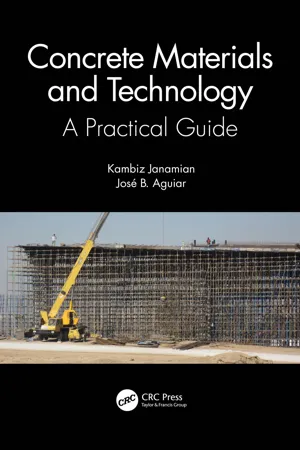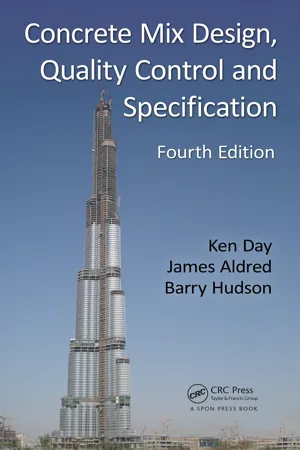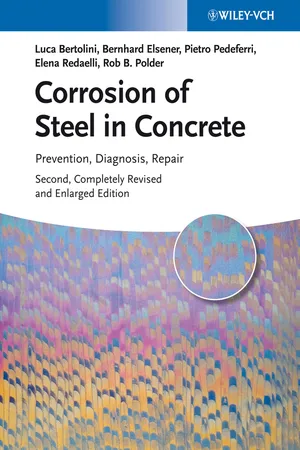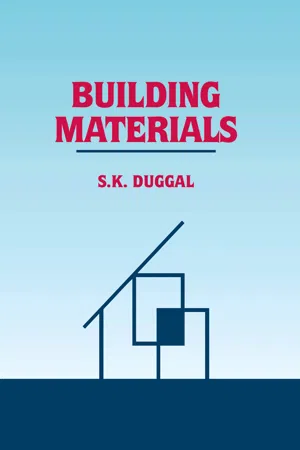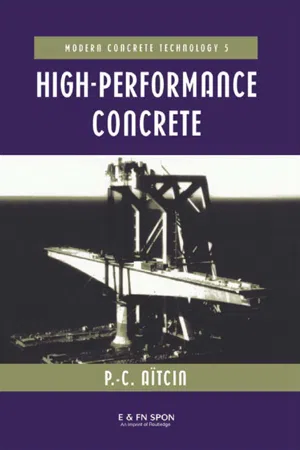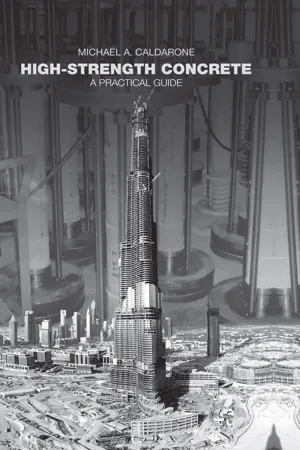Technology & Engineering
Properties of Concrete
The properties of concrete refer to its characteristics and behavior, including strength, durability, workability, and permeability. These properties are influenced by factors such as the mix design, curing conditions, and the type and proportion of aggregates and cement used. Understanding and controlling these properties is essential for ensuring the performance and longevity of concrete structures.
Written by Perlego with AI-assistance
Related key terms
Related key terms
1 of 4
Related key terms
1 of 3
7 Key excerpts on "Properties of Concrete"
- eBook - ePub
Concrete Materials and Technology
A Practical Guide
- Kambiz Janamian, José Aguiar(Authors)
- 2023(Publication Date)
- CRC Press(Publisher)
1 Introduction to Concrete TechnologyDOI: 10.1201/9781003384243-1Concrete is the most important construction material with a high amount of usage in the structures, because:- It is very simple to find its constituent materials everywhere.
- Fresh concrete is a flexible material. So, you can shape it with all types of forms.
- The compressive strength of hardened concrete is very good. We can make a concrete with more than 300 MPa compressive strength nowadays.
- When we use concrete combined with steel bars or steel fibers, the tensile and flexural strength of the mix will be very good.
Concrete technology is the technique for the preparation of high-quality constituent materials and mixing them. It seems that it is a simple work. But really it is not. The importance of choosing suitable constituent materials and good proportions is one of the most advanced techniques in civil engineering.This chapter is the start for a concrete technologist. You should start with some of the most important expressions and definitions of concrete technology. This fundamental knowledge is necessary to continue the other subjects of the book.Every page of this chapter contains many important definitions and concepts that you should learn about the concrete technology. We will use these concepts in the following chapters too many times. So, for beginners, this chapter is the base of other chapters.Let’s start our journey with the concrete constituent materials.1.1 Concrete Constituent Materials
Concrete is a mixture of below materials:- Portland cement (Figure 1.1 ): It is a kind of powder, which contains calcium silicates and calcium aluminate chemicals. This is the main binder in concrete, which reacts with water to harden. This is also the main material for the smoothness of concrete. We can use about 300–600 kg of Portland cement in 1 m3 of concrete which is about 10%–25% by weight of concrete and about 9%–18% by volume of concrete.
FIGURE 1.1
- Ken W. Day, James Aldred, Barry Hudson(Authors)
- 2013(Publication Date)
- CRC Press(Publisher)
Properties of ConcreteBefore starting to design (or specify) concrete, it is necessary to consider what properties we want the concrete to have and also what properties we do not want it to have. Some properties may come under both headings, such as heat generation, but generally undesirable properties are simply a lack of desirable properties.Important properties include- Durability
- Strength
- Water/ion transport
- Rheology
- Dimensional stability
- Good appearance
- Economy
- Sustainability
5.1 durability
Durability must come first on our list because if our concrete does not achieve the required design life, it cannot display any of the other desirable properties (not even economy because the most expensive concrete you can get is that which has to be replaced!). However there is a difference between durability for a few years, a few decades, or a few centuries, between durability at any price and “reasonable” durability of economical concrete, and durability in benign or aggressive environments. More particularly there is a difference between the durability of plain concrete and the durability of reinforced concrete.5.1.1 Corrosion of reinforcement
Generally, reinforcement is the Achilles’ heel of concrete. We are all familiar with cracked, rust-stained concrete caused by the expansion of reinforcing steel. Roman concrete was not reinforced and this is a major reason for its survival for centuries. However, as we shall see, there can be durability problems with unreinforced concrete aside from structural issues.The major factor in the corrosion of reinforcing steel is the thickness and quality of the concrete cover. In theory, without adequate cover, concrete cannot protect the reinforcement. However excessive cover means that the surface concrete is essentially unreinforced and can crack due to thermal stresses or shrinkage, sometimes with the reinforcing cage acting as a crack inducer. Therefore, specifications that call for 100 mm cover or more may result in no effective cover whatsoever! The good durability of spun pipes, ferrocement, and steel fibre reinforced concrete with limited or negligible cover to the reinforcement highlights that corrosion is a complicated subject and there can be exceptions to the general rules.- eBook - ePub
Corrosion of Steel in Concrete
Prevention, Diagnosis, Repair
- Luca Bertolini, Bernhard Elsener, Pietro Pedeferri, Elena Redaelli, Rob B. Polder(Authors)
- 2013(Publication Date)
- Wiley-VCH(Publisher)
12 Concrete Technology for Corrosion PreventionPrevention of reinforcement corrosion is strongly related to the Properties of Concrete. Even if additional preventative measures are adopted, a suitable quality has to be assured for the concrete. This chapter outlines aspects of concrete technology that are related to the protection of the embedded reinforcement.12.1 Constituents of Concrete
Concrete is formed by mixing cement, coarse and fine aggregate, water, and often by the incorporation of admixtures [1–4]. Selection of the constituents is the first step for obtaining durable concrete, as their properties influence the behavior of fresh and hardened concrete.12.1.1 Cement
The presence of many types of cement [5], as illustrated in Chapter 1 , shows that there is no single cement that is the best choice under all circumstances. In the past, pure portland cement was most favored; nowadays advantages related to the use of other types of cements have been clearly demonstrated, especially regarding durability. Environmental issues, and especially the reduction of carbon dioxide emissions during manufacturing, also contribute to the development of new binders. The type of cement may influence various properties of the hardened concrete or its production technology, such as high early strength, heat of hydration, resistance to environmental aggressiveness, potential reactivity with reactive aggregates, curing conditions. Proper selection and use of cement can contribute to finding the most economical balance of properties desired for a particular concrete mixture [1, 4].For general use, that is, when the environment has a mild aggressiveness and the strength requirements for concrete are in the usual range, most cements can be suitable. In that case the selection is made on the basis of cost or local availability. Portland and portland-composite cements with strength class 32.5 or 42.5 are nowadays available as general-purpose cements. Although in several European countries portland-limestone cements can be found (Table 1.3), cements blended with pozzolanic addition or blast furnace slag should be preferred, because these types of addition contribute to hydration reactions and thus to the reduction in porosity and permeability of the cement paste, while limestone has a negligible effect (Figure 1.10). - eBook - ePub
- S.K. Duggal(Author)
- 2017(Publication Date)
- Routledge(Publisher)
Most of the ancient structures and historical buildings had been constructed with lime concrete. With the advent of cement, the use of lime concrete has been confined to making bases for concrete foundations and roof terracing. The major factors responsible for wide usage of cement-concrete are mouldability, early hardening, high early compressive strength, development of desired properties with admixtures to be used in adverse situations, suitability for guniting, pumpability and durability. Most of the chapter is devoted to cement concrete because of its versatility. The simple reason for its extensive use in the construction of almost all civil engineering works is that the properties can be controlled within a wide range by using appropriate ingredients and by special mechanical, physical and chemical processing techniques. Buildings — from single storey to multistorey, bridges, piers, dams, weirs, retaining walls, liquid retaining structures, reservoirs chimneys, bins, silos, runways, pavements, shells, arches, railway sleepers are but a few examples of cement concrete applications.10.2 Classification
Based on Cementing Material Concretes are classified as lime concrete, gypsum concrete and cement concrete.Based on Perspective Specifications The cement concrete is specified by proportions (by weight) of different ingredients, e.g. 1(cement) : 11/2 (fine aggregate) : 3 (coarse aggregate). It is presumed that by adhering to such perspective specifications satisfactory performance may be achieved. The usual mix proportions of cement concrete are given in Table 10.1 . Here, M refers to the mix.Based on Performance Oriented SpecificationsTable 10.1 Mix Proportions of Cement Concrete - eBook - ePub
- Pierre-Claude Aïtcin(Author)
- 1998(Publication Date)
- CRC Press(Publisher)
CHAPTER 16
Mechanical properties of high-performance concrete
16.1 INTRODUCTION
It is not the intention of this chapter to cover in full detail each of the mechanical properties of normal weight high-performance concretes, as an entire volume could be dedicated to such a subject. Moreover, there are so many types of high-performance concrete made from so many different materials that are used in so many applications and conditions that it would be presumptuous to try to cover all of the mechanical properties of these different mixes in one chapter. In this chapter, we will rather review the mechanical properties of high-performance concrete in a more general manner, keeping in mind what makes the mechanical properties of high-performance concrete different yet similar to those of usual concrete (Perenchio and Klieger, 1978; Swamy, 1986; Nilson, 1987; Olsen, Krenchel and Shah, 1987; Castillo and Durrani, 1990; Xie, Elwi and MacGregor, 1995).It is wrong to believe that the mechanical properties of a high-performance concrete are simply those of a stronger concrete. It is also as wrong to consider that the mechanical properties of high-performance concrete can be deduced by extrapolating those of usual concretes as it would be wrong to consider that none of them are related. It is also wrong to apply blindly the relationships linking the mechanical properties of a usual concrete to its compressive strength that were developed through the years for usual concretes found in codes and textbooks. As will be seen in this chapter, it is better to examine the different mechanical properties case by case and to consider the influence of the fundamental mechanisms relating concrete microstructure to the macrostructural property under evaluation.Certainly there are cases when high-performance concrete behaves simply as a stronger concrete, but there are also other cases when high-performance concrete behaves quite differently. These differences in the mechanical behaviour of high-performance concrete and usual concrete result from their different microstructures, so an external load applied on the concrete does not necessarily develop the same stress field within the concrete and the material does not respond in the same way to this stress field. - eBook - ePub
- P.K. Jayasree, K Balan, V Rani(Authors)
- 2021(Publication Date)
- CRC Press(Publisher)
9 Concrete Technology9.1 Fresh Concrete
Concrete remains in its fresh state from the time it is mixed until it sets. It is during this time that the concrete is handled, transported, placed, and compacted. Properties of Concrete in its fresh state are very important because it influences the quality of the hardened concrete. Fresh concrete is that stage of concrete in which concrete can be moulded and it is in plastic state. This is also called “Green Concrete.”9.1.1 Properties of Fresh Concrete
9.1.1.1 Consistency
Consistency of a concrete mix is a measure of the stiffness or fluidity of the mix. It indicates the easiness of flow of concrete. Slump test is commonly used to measure consistency of concrete.9.1.1.2 Setting of Concrete
The hardening of concrete before its hydration is known as setting of concrete. It is the transition process of changing of concrete from plastic state to hardened state. Following are the factors that affect the setting of concrete:- Water cement (w/c) ratio
- Suitable temperature
- Cement content
- Type of cement
- Fineness of cement
- Relative humidity
- Admixtures
- Type and amount of aggregate
9.1.1.3 Workability
The workability of a concrete mix is the relative ease with which concrete can be placed, compacted, and finished without separation or segregation of the individual materials. As the strength of concrete is adversely and significantly affected by the presence of voids in the compacted mass, it is vital to achieve a maximum possible density. Presence of voids in concrete reduces the density and greatly reduces the strength, 5% of voids can lower the strength by as much as 30%. Slump test can be used to find out the workability of concrete.Factors affecting workability of concrete are as follows:- Water content or w/c ratio
- eBook - ePub
High-Strength Concrete
A Practical Guide
- Michael A. Caldarone(Author)
- 2014(Publication Date)
- CRC Press(Publisher)
Electrochemical induced deterioration causing oxidation of embedded steel reinforcement and the development of internal pressures and subsequent spalling and cracking of the concrete. The adequacy of the protection concrete provides against the corrosion of embedded steel reinforcement depends on several factors, including the amount of concrete cover over the steel, the properties of the concrete (particularly permeability) and the degree the concrete is exposed to chlorides. High-strength concrete, a material of inherently low permeability has the potential to provide excellent protection against corrosion, if adequate attention is given to raw material selection, mixture proportioning, design, and construction. ACI 201.2R provides an extensive discussion of specific deterioration mechanisms of concrete, the recommended requirements for individual components, quality considerations for concrete mixtures, and construction practices. For further information on the durability properties of high-strength concrete, refer toACI 363R.Thermal properties
The thermal Properties of Concrete are of special concern in structures where thermal differentials may occur from environmental effects, including solar heating of pavements and bridge decks. The thermal Properties of Concrete are more complex than for most other materials, not only because concrete is a composite material whose components have different thermal properties, but because its properties also depend on moisture content and porosity. Early research on the effects of elevated temperature on concrete material properties and performance in large measure was in support of the development of prestressed concrete pressure vessels for nuclear power plant designs.Data on thermal properties of high-performance concrete is limited, although the thermal properties of high-strength concrete fall approximately within the same range as those of lower-strength concrete, for characteristics such as specific heat, diffusivity, thermal conductivity and coefficient of thermal expansion (Farny and Panarese, 1994). Burg and Ost (1992) measured the coefficient of thermal expansion of five commercially available high-strength concrete in the Chicago area and they found that the coefficient varied between 9.4 and 12.3µm/m/°C (5.2 to 6.8 µ-in/in/°F).
Index pages curate the most relevant extracts from our library of academic textbooks. They’ve been created using an in-house natural language model (NLM), each adding context and meaning to key research topics.
Explore more topic indexes
Explore more topic indexes
1 of 6
Explore more topic indexes
1 of 4
